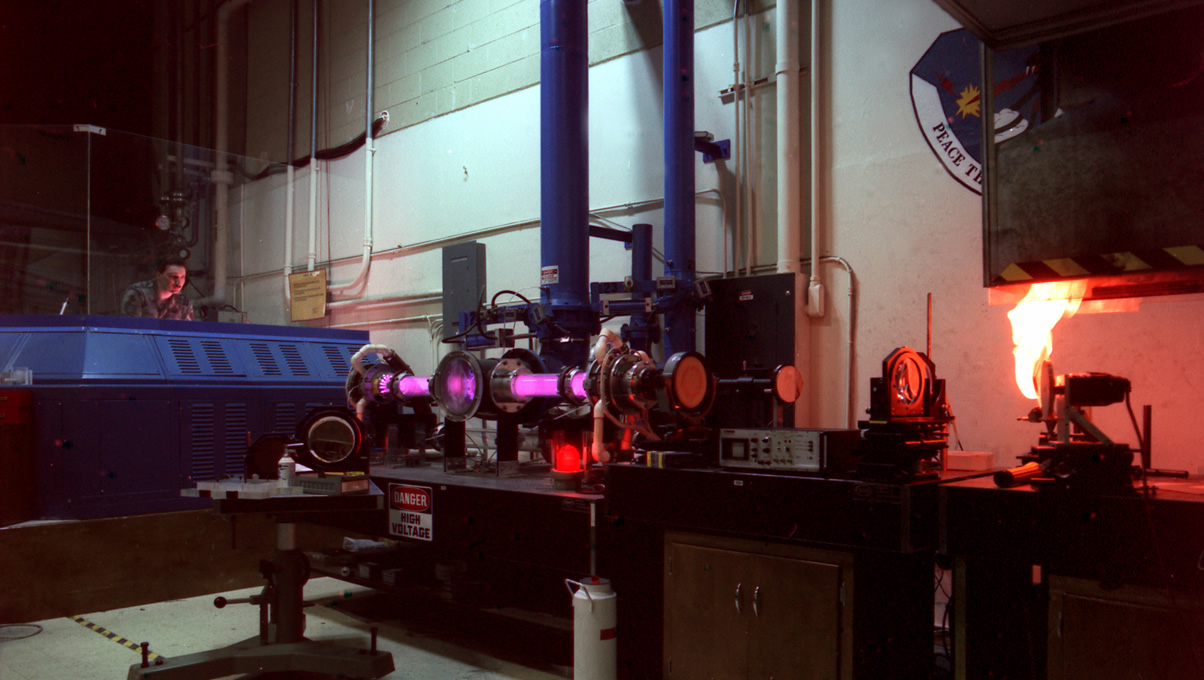Carbon dioxide laser
 From Wikidoc - Reading time: 5 min
From Wikidoc - Reading time: 5 min
Overview[edit | edit source]
The carbon dioxide laser (CO2 laser) was one of the earliest gas lasers to be developed (invented by Kumar Patel of Bell Labs in 1964[1]), and is still one of the most useful. Carbon dioxide lasers are the highest-power continuous wave lasers that are currently available. They are also quite efficient: the ratio of output power to pump power can be as large as 20%.
The CO2 laser produces a beam of infrared light with the principal wavelength bands centering around 9.4 and 10.6 micrometers.
Amplification[edit | edit source]

The active laser medium (laser gain/amplification medium) is a gas discharge which is air cooled (water cooled in higher power applications). The filling gas within the discharge tube consists primarily of:
- Carbon dioxide (CO
2) (around 10–20 %) - Nitrogen (N
2) (around 10–20%) - Hydrogen (H
2) and/or xenon (Xe) (a few percent; usually only used in a sealed tube.) - Helium (He) (The remainder of the gas mixture)
The specific proportions vary according to the particular laser.
The population inversion in the laser is achieved by the following sequence:
- Electron impact excites vibrational motion of the nitrogen. Because nitrogen is a homonuclear molecule, it cannot lose this energy by photon emission, and its excited vibrational levels are therefore metastable and live for a long time.
- Collisional energy transfer between the nitrogen and the carbon dioxide molecule causes vibrational excitation of the carbon dioxide, with sufficient efficiency to lead to the desired population inversion necessary for laser operation.
Construction[edit | edit source]
Because CO2 lasers operate in the infrared, special materials are necessary for their construction. Typically, the mirrors are made of coated silicon, molybdenum, or gold, while windows and lenses are made of either germanium or zinc selenide. For high power applications, gold mirrors and zinc selenide windows and lenses are preferred. Historically, lenses and windows were made out of salt (either sodium chloride or potassium chloride). While the material was inexpensive, the lenses and windows degraded slowly with exposure to atmospheric moisture.
The most basic form of a CO2 laser consists of a gas discharge (with a mix close to that specified above) with a total reflector at one end, and an output coupler (usually a semi-reflective coated zinc selenide mirror) at the output end. The reflectivity of the output coupler is typically around 5-15%. The laser output may also be edge-coupled in higher power systems to reduce optical heating problems.
The CO2 laser can be constructed to have CW powers between milliwatts (mW) and hundreds of kilowatts (kW).[2] It is also very easy to actively Q-switch a CO2 laser by means of a rotating mirror or an electro-optic switch, giving rise to Q-switched peak powers up to gigawatts (GW) of peak power[3].
Because the laser transitions are actually on vibration-rotation bands of a linear triatomic molecule, the rotational structure of the P and R bands can be selected by a tuning element in the laser cavity. Because transmissive materials in the infrared are rather lossy, the frequency tuning element is almost always a diffraction grating. By rotating the diffraction grating, a particular rotational line of the vibrational transition can be selected. The finest frequency selection may also be obtained through the use of an etalon. In practice, together with isotopic substitution, this means that a continuous comb of frequencies separated by around 1 cm-1 (30 GHz) can be used that extend from 880 to 1090 cm-1. Such "line-tuneable" carbon dioxide lasers are principally of interest in research applications.
Applications[edit | edit source]
Because of the high power levels available (combined with reasonable cost for the laser), CO2 lasers are frequently used in industrial applications for cutting and welding, while lower power level lasers are used for engraving. They are also very useful in surgical procedures because water (which makes up most biological tissue) absorbs this frequency of light very well. Some examples of medical uses are laser surgery, skin resurfacing ("laser facelifts") (which essentially consist of burning the skin to promote collagen formation), and dermabrasion. Also, it could be used to treat certain skin conditions such as hirsuties papillaris genitalis by removing embarrassing or annoying bumps, podules, etc.
Because the atmosphere is quite transparent to infrared light, CO2 lasers are also used for military rangefinding using LIDAR techniques.
See also[edit | edit source]
References[edit | edit source]
- ↑ Patel, C. K. N. (1964). "Continuous-Wave Laser Action on Vibrational-Rotational Transitions of CO2". Physical Review. 136 (5A): A1187–A1193. doi:10.1103/PhysRev.136.A1187.
- ↑ Air Force Research Lab's 150 kW CO2 Laser
- ↑ Brookhaven National Lab's Carbon Dioxide Amplifier
External links[edit | edit source]
ca:Làser de diòxid de carboni de:Kohlendioxidlaser hr:CO2 laser nl:Koolstofdioxidelaser it:Laser ad anidride carbonica
 KSF
KSF